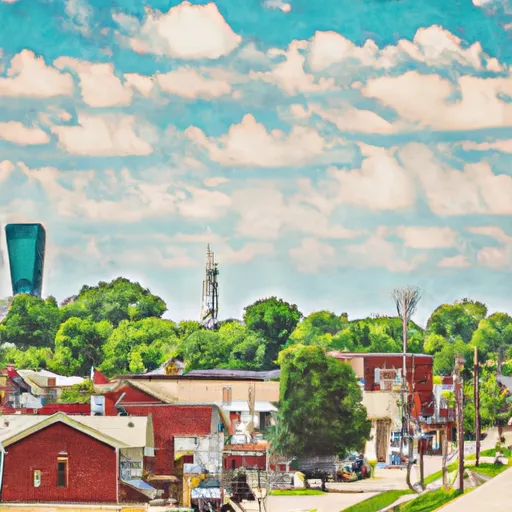-
 Snoflo Premium
Snoflo Premium
Get unlimited access to all our content
With no Ad interruptions! - Start Your Free Trial Login with existing account
New-Trenton
Eden Index
Climate
8.3
•
Recreation
4.7
•
Community
1.1
•
Safeguard
5.2/10

New Trenton, Indiana is a charming town located in the southeastern part of the state. The climate in New Trenton is characterized by warm summers and cold winters, with average temperatures ranging from the mid-20s°F (-4°C) in January to the mid-80s°F (29°C) in July. The town is nestled near the Whitewater River, which provides a variety of hydrology constituents. The river is popular for canoeing and fishing, offering opportunities to catch smallmouth bass, catfish, and more. Outdoor enthusiasts can also explore nearby hiking trails, such as the Whitewater Memorial State Park, which boasts beautiful scenery and a range of recreational activities. With its picturesque landscapes and diverse outdoor activities, New Trenton is a haven for nature lovers.
What is the Eden Index?
The Snoflo Eden Index serves as a comprehensive rating system for regions, evaluating their desirability through a holistic assessment of climate health, outdoor recreation opportunities, and natural disaster risk, acknowledging the profound impact of these factors on livability and well-being.
Climate Health Indicator (CHI): 8.3
New-Trenton receives approximately
1145mm of rain per year,
with humidity levels near 81%
and air temperatures averaging around
12°C.
New-Trenton has a plant hardyness factor of
6, meaning
plants and agriculture in this region thrive during a short period during spring and early summer. Most
plants will die off during the colder winter months.
By considering the ideal temperature range, reliable water supplies, clean air, and stable seasonal rain or snowpacks, the Climate Health Indicator (CHI) underscores the significance of a healthy climate as the foundation for quality living.
A healthy climate is paramount for ensuring a high quality of life and livability in a region, fostering both physical well-being and environmental harmony. This can be characterized by ideal temperatures, reliable access to water supplies, clean air, and consistent seasonal rain or snowpacks.
Weather Forecast
Streamflow Conditions
Great Miami
Area Rivers
Great Miami
Snowpack Depths
Great Miami
Reservoir Storage Capacity
Great Miami
Groundwater Levels
Recreational Opportunity Index (ROI): 4.7
The Recreational Opportunity Index (ROI) recognizes the value of outdoor recreational options, such as parks, hiking trails, camping sites, and fishing spots, while acknowledging that climate plays a pivotal role in ensuring the comfort and consistency of these experiences.
Access to outdoor recreational opportunities, encompassing activities such as parks, hiking, camping, and fishing, is crucial for overall well-being, and the climate plays a pivotal role in enabling and enhancing these experiences, ensuring that individuals can engage in nature-based activities comfortably and consistently.
Camping Areas
| Campground | Campsites | Reservations | Toilets | Showers | Elevation |
|---|---|---|---|---|---|
| Lake Cumberland State Park | 150 | 911 ft | |||
| Governor Bebb Preserve | None | 729 ft | |||
| Big Bone Lick State Park | 60 | 496 ft | |||
| Fishing Creek - Lake Cumberland | 45 | 805 ft | |||
| Miami Whitewater Forest | 50 | 543 ft | |||
| Brookville Lake | 465 | 694 ft | |||
| Cumberland Point - Lake Cumberland | 30 | 906 ft | |||
| Franklin County Park | None | 662 ft | |||
| Paul Ogle Riverfront Park | None | 451 ft | |||
| Boat Ramp - Elmer Davis Lake - DFWR | None | 735 ft |
Nearby Fishing
Nearby Ski Areas
Catastrophe Safeguard Index (CSI):
The Catastrophe Safeguard Index (CSI) recognizes that natural disaster risk, encompassing floods, fires, hurricanes, and tornadoes, can drastically affect safety and the overall appeal of an area.
The level of natural disaster risk in a region significantly affects safety and the overall livability, with climate change amplifying these risks by potentially increasing the frequency and intensity of events like floods, fires, hurricanes, and tornadoes, thereby posing substantial challenges to community resilience and well-being.
Community Resilience Indicator (CRI): 1.1
The Community Resilience Indicator (CRI) recognizes that education, healthcare, and socioeconomics are crucial to the well-being of a region. The CRI acknowledges the profound impact of these elements on residents' overall quality of life. By evaluating educational resources, healthcare accessibility, and economic inclusivity, the index captures the essential aspects that contribute to a thriving community, fostering resident satisfaction, equity, and social cohesion.

